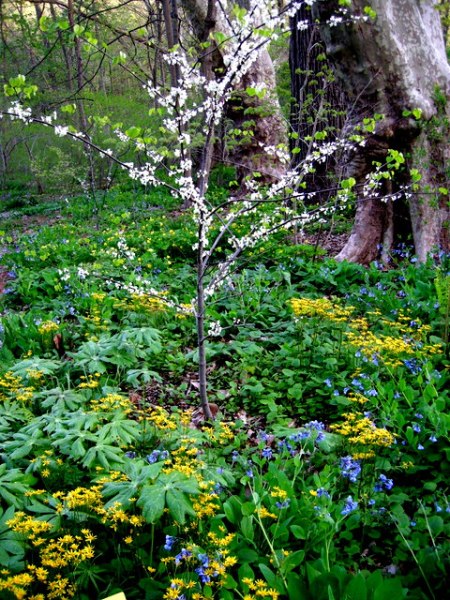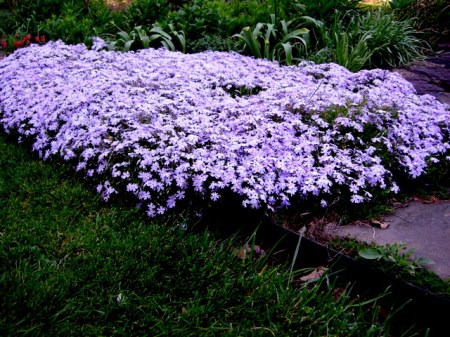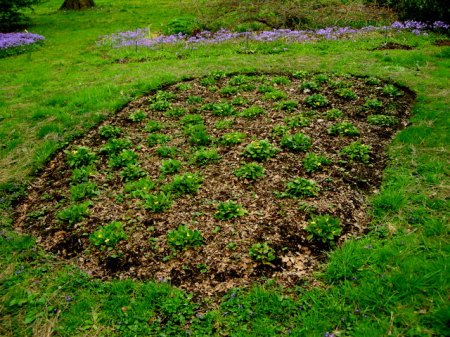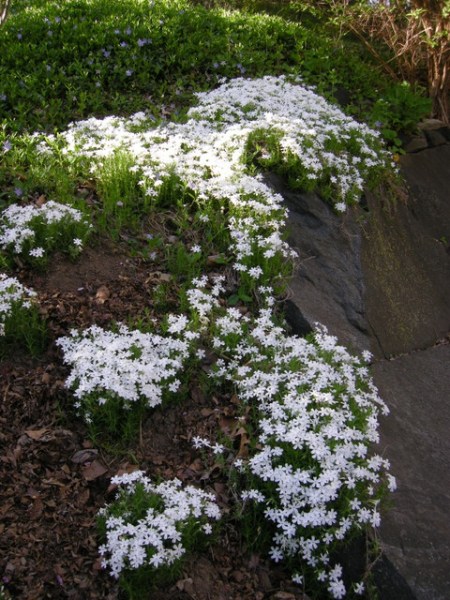
Golden groundsel, Senecio aureus, is the best native plant for ground cover.
I write a lot about the things we do at Carolyn’s Shade Gardens to support the environment: gardening organically without herbicides and chemical fertilizers, doing little supplemental watering, composting, mulching with ground leaves, getting rid of our lawn, landscaping with large quantities of native plants, and promoting natives at the nursery.
Nursery News: Carolyn’s Shade Gardens is a retail nursery located in Bryn Mawr, PA, specializing in showy, colorful, and unusual plants for shade. The only plants that we ship are snowdrops and miniature hostas. For catalogues and announcements of events, please send your full name, location, and phone number (for back up use only) to carolyn@carolynsshadegardens.com. Click here to get to the home page of our website for catalogues and information about our nursery and to subscribe to our blog.
.

Our native white-flowered redbud surrounded by native plants.
You can read more about these practices in these posts among others:
Your Native Woodland: If You Build it They Will Come, how to create your own woodland filled with native plants
My Thanksgiving Oak Forest, the importance of native plants to our survival
Your Most Precious Garden Resource, step-by-step guide to mulching with ground leaves
Letting Go Part 1: The Lawn, the dangers of lawn chemicals to ourselves and the environment
Do You Know Where Your Mulch Comes From?, toxic substances in shredded hardwood mulch
.
Our woodland in April with Virginia bluebells, wild ginger, golden groundsel, and mayapples—all native.
My guide to creating a native woodland has been especially popular. However, most gardeners don’t have vast areas of woods to convert to native plants but still want to make a difference. And I am sure that most people realize that planting three milkweed plants, though admirable and to be encouraged, is not going to save the monarch butterflies. So what can you do?
.
Native white violets, Viola striata, used in quantity as an edging along the front of a border. The violets spread rapidly by seed, filling in empty areas and preventing weeds.
One solution is to find ways to include large quantities—a critical mass—of native plants in your garden, no matter what size. You can accomplish this by replacing non-native ground covers like pachysandra, vinca, ivy, euonymus, and turf grass with native ground cover plants. It is easy to do and you can start small by using spreading native plants like the violets above as edging for your existing beds. Soon you will be eliminating whole swathes of your lawn! Here are some more ideas of plants to use:


This patch of native ‘Emerald Blue’ moss phlox has been in place for at least a decade and requires no maintenance at all. It is evergreen so is present year round like pachysandra but provides you with beautiful flowers and the native insects with food. Its mat-like habit excludes all weeds.
.

Native ‘Nice ‘n White’ moss phlox used to replace non-native vinca, which you can see behind it. This location is quite shady and the moss phlox thrives. All it needs is good drainage.
.
Our original planting of native ‘Nice ‘n White’ moss phlox is filling in to create a solid blanket while we continue to move down the hill adding new plants.
.
Native ‘Tennessee White’ dwarf crested iris, Iris cristata, used to edge our raised beds. I expect these clumps to double in size by next spring.
.

Native golden groundsel, Senecio aureus, the yellow flower in the photo above and the first photo, makes the best ground cover of any native plant. It spreads aggressively and is evergreen and mat-forming like pachysandra but also produces beautiful, fragrant flowers suitable for cutting. Like pachysandra it is too aggressive to be mixed with other plants, but unlike the pachysandra in our area it is not subject to alfalfa mosaic virus.
.
Native goldenstar, Chrysogonum virginianum, is another creeping plant that makes a good edger.
.

Because the goldenstar was working so well at the edge, we decided to replace a whole section of our lawn with it.
.

Two years ago we replaced another section of our lawn with native ‘Sherwood Purple’ creeping phlox, P. stolonifera. This phlox grows in part to full shade and forms a flat, weed-choking mat that stays green all winter.
.
Native blue wood aster, Aster cordifolius, replaced another section of lawn at Carolyn’s Shade Gardens that surrounded a gigantic black walnut.
.
Native blue wood aster blooms in the fall and grows in part to full shade.
.
Doug Tallamy explains in his amazing book Bringing Nature Home* that we can make a difference for the environment and the plants and animals (including us) which are struggling to survive there, by planting native plants in our suburban gardens. I hope I have given you some good ideas for accomplishing this laudable goal.
*Profiled in my blog post My Thanksgiving Oak Forest.
Carolyn
.
Nursery Happenings: You can sign up to receive catalogues and emails about nursery events by sending your full name and phone number to carolynsshadegardens@verizon.net. Subscribing to my blog does not sign you up to receive this information.
Carolyn’s Shade Gardens is a local retail nursery in Bryn Mawr, Pennsylvania, U.S., zone 6b/7a. The only plants that we mail order are snowdrops and miniature hostas and only within the US.
Facebook: Carolyn’s Shade Gardens has a Facebook Page where I post single photos, garden tips, and other information that doesn’t fit into a blog post. You can look at my Facebook page here or click the Like button on my right sidebar here.
Notes: Every word that appears in orange on my blog is a link that you can click for more information. If you want to return to my blog’s homepage to access the sidebar information (catalogues, previous articles, etc.) or to subscribe to my blog, just click here.





















